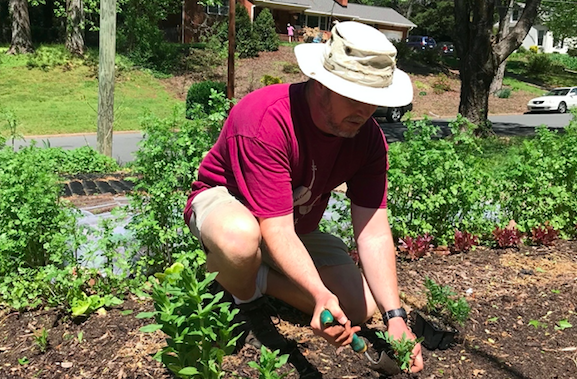It's planting season in the Piedmont, and during the pandemic, more people than ever are out in the garden. For some it's a way to pass the time, but others just want to make sure they've got access to fresh food in the new age of panic buying and shortages in local grocery stores.
A lot of newcomers to planting are sowing their very first summer crops and they're loaded with questions. Winston-Salem gardener Matt Mayers has the answers. He's overseen community gardens large and small for years, and one look at his front yard confirms it — a dozen small gardening plots with kale, collards, lettuce, herbs, and more. There's also a grapevine trellis, half-dozen fruit trees and several berry bushes.
It's an amazing display of gardening prowess, and thankfully, Mayers is happy to share the secrets of his success. 
TOMATOES
1. Don't jump the gun! Wait to plant until May 1.
“By putting them in now, what you'll get is your plants out there near the soil, exposed to more pathogens for longer,” Mayers says.
2. Prepare your plants first: strip most of the leaves off, and plant it deep.
“The main stem will create adventitious roots — little side roots — for a very strong root structure,” says Mayers.
A couple of sets of leaves above ground are all you need to start, just make sure they don't droop and touch the soil.
3. Keep branches pruned to just one or two sturdy central stalks.
“That'll yield the best fruit, more of it, and it improves airflow,” advises Mayers.
SUMMER SQUASH
1. Beware the borers (boring insects that get into squash vines, killing the plants).
Mayers suggested taking a little bit of foil and wrapping around the base of the plant so that it's hard to bore into it.
2. Surround your squash with radishes.
“Turns out the bugs that like to eat your squash and melons really don't like radishes,” says Mayers.
3. Mildew issues? Milk (with a sprayer) is a natural.
“Diluted milk actually works as well as any of the chemical solutions for damping down powdery mildew on squash plants. I like a one-to-one ratio," says Mayers.
4. Give them their space.
“You have to imagine the plant at full maturity and yourself trying to get in there to harvest," adds Mayers. "I put squash plants three feet apart at a minimum because they're going to sprawl.”
BASIL
1. Be patient! Wait to plant until last week in April or first week in May.
“Basil — like tomatoes — doesn't want to be put out cold,” says Mayers.
2. Avoid overhead watering.
“Unfortunately, the kind of mildew that goes after basil has gotten to be much more common in this area,” he says.
3. Keep it well picked and cut off the flowers.
“The bees won't be very happy with you. But the plant will branch, and you'll get more basil.”
4. Overgrown? Don't be afraid to hack.
“If it gets away from you, grab some shears and cut the whole plant down to, say, eight to ten inches above the ground level," Mayers says. "It'll look terrible, and then in a week, you'll have a whole bunch more basil leaves.”
WATERING
1. Just say “No,” to overhead watering. Try setting up a drip line instead.
“You really want to keep the moisture in the soil as much as possible instead of watering the weeds and sidewalks.”
EXPERIMENT
1. Plant the things you like but don't be afraid to try a few things you're not familiar with as well.
“For example, there are some new turnip varieties out there that are so
sweet that you just eat them fresh and raw like candy!” says Mayers.
Happy gardening, and bon appetit!
EDITOR'S NOTE: This transcript was lightly edited for clarity.
300x250 Ad
300x250 Ad
